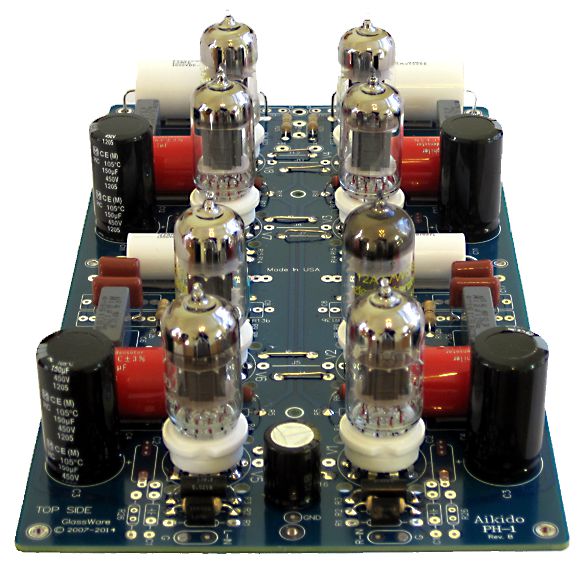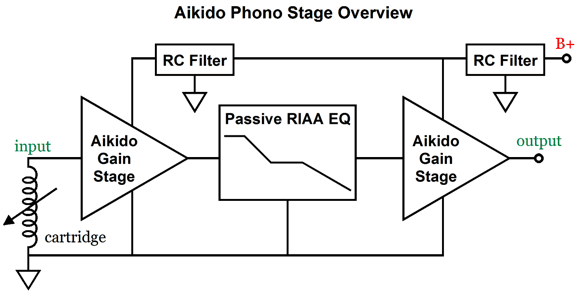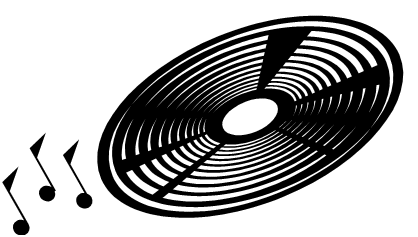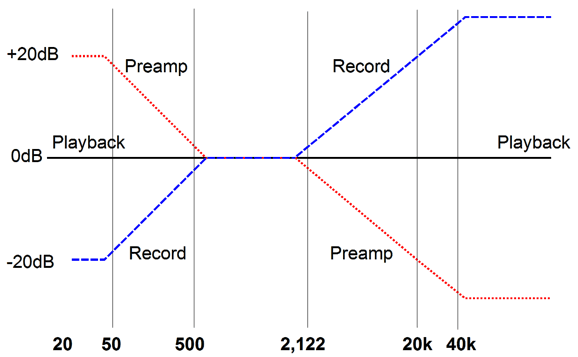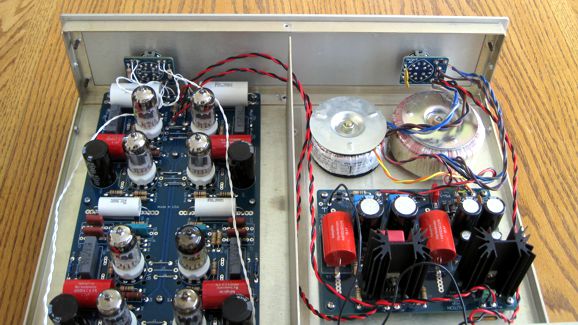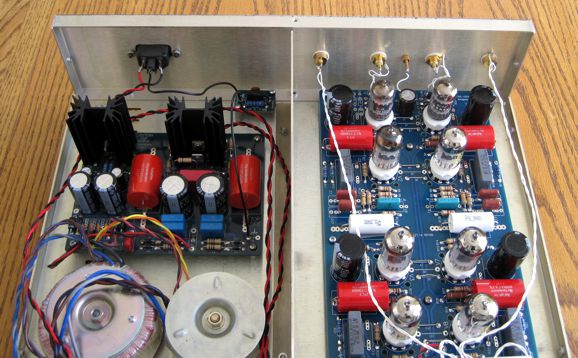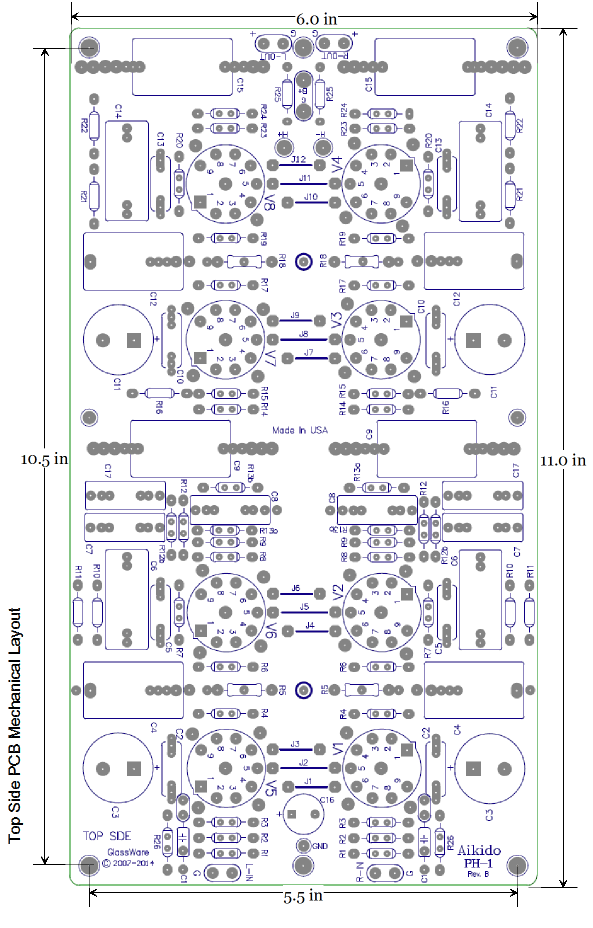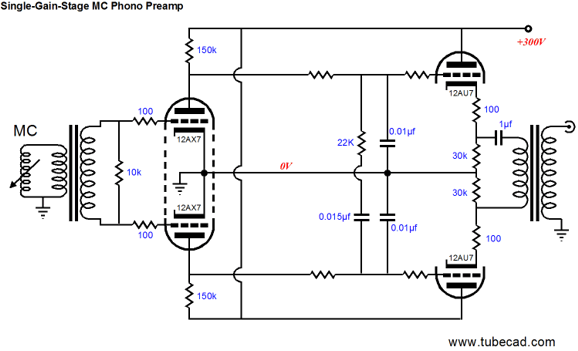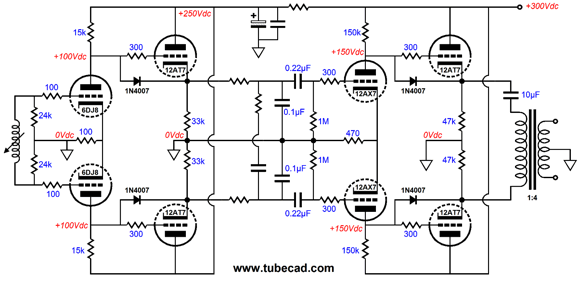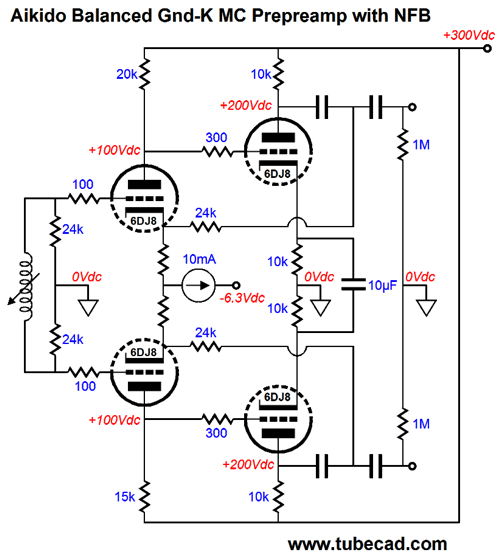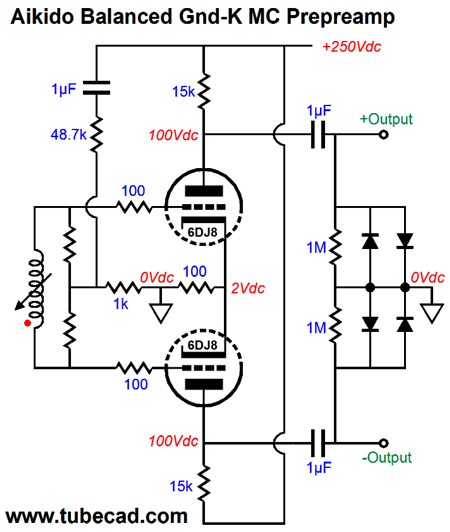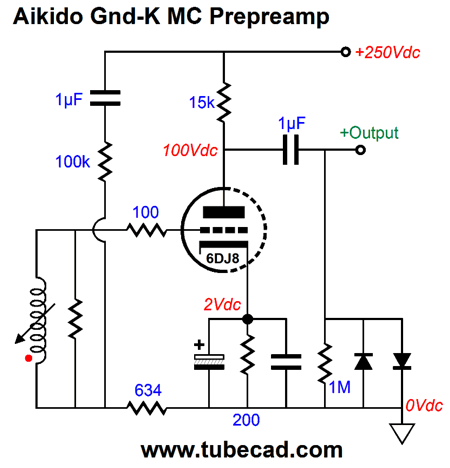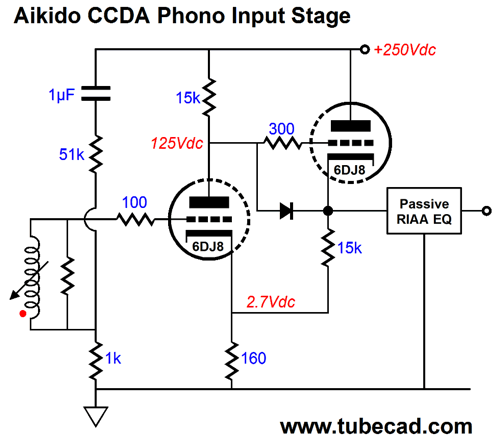| John Broskie's Guide to Tube Circuit Analysis & Design |
22 August 2015 At Last: The Return of the
Aikido Phono preamp, Rev. B
Thus, eight tubes are needed, as each AIkido gain stage requires two tubes. In addition, each Aikido gain stage gets its own RC filter to isolate it from the B+ connection, thereby furthering enhancing the already fine PSRR. Great, John, but who would want a tube phono preamplifier, in a world filled with iPods and streaming digital audio? I would, for one.
Despite predictions to the contrary, spinning vinyl to the warm glow of vacuum tubes persists. In spite of the popularly held belief that both LPs and tubes are dead, long dead— most believe that the vacuum tube died about 50 years ago along with black & white TVs and that the long-playing record died 35 years ago at the birth of the CD—both tubes and LPs grow more popular with each coming day. Tubes simply refuse to fade away and solid-state audio gear continues to be—embarrassingly—advertised as sounding tube-like, just as high-resolution digital music files are said to sound more like analog; and turntables and phono cartridges continue to be developed and sold and new records continue be pressed daily. Both tubes and LPs, or as the Britts say V & V (valves and vinyl), are here to stay. If you were born in the last 30 years, your might wonder: Why do we need a phono preamp? The answer is simple. The phono cartridge's minuscule output signal, being only millivolts, is too weak to drive a power amplifier, even with a line-stage amplifier's help; in addition, its output signal is not flat, as the signal coming off the LP's surface is not flat, having been equalized with boosted highs and attenuated lows. Thus, a phono preamp both amplifies and flattens the frequency response.
Regardless of the underling technology used, tube or solid-state, a phono preamp must undo the RIAA (Recording Institute Association of America) equalization curve or the CCIR (Comité Consultatif International des Radiocommunications) or IEC (International Electrotechnical Commission) the European versions of the RIAA) curve used in making the record. Why was this curve imposed on the records? Using it improved the signal-to-noise ratio of the record by boosting the highs going to the cutting head, while greatly extending the play-back time by cutting the lows. The end result was a fairly even grove cut, regardless of the frequency. The inverse of the RIAA curve returns the signal to flat by cutting the highs and boosting the bass. (Bear in mind that most records made before 1950 may not have followed the RIAA curve, but held some other proprietary-to-the-record-label equalization curve.) In the Aikido PH-1, the first Aikido gain stage amplifies the cartridge's tiny output voltage and then passes the signal to the passive inverse RIAA equalization network, which boosts the lows and attenuates the highs, restoring a flat signal, but at the cost of an insertion loss of -20dB. The second Aikido gain stage then further amplifies the flat signal, bringing it up to a useable level. The final gain of the preamp can vary from 30dB to 48dB, depending on the tubes used. If a low-output moving-coil cartridge is used, then either a step-up transformer or a pre-preamp will be needed. The Aikido PH-1 phono preamp is an extremely flexible design, as a nearly infinite number of different Aikido Phono Stage configurations can be built on the PCB. Nonetheless, our goals always remain constant: high-gain, low-noise, and low output impedance. The input tubes (V1, V5, V3, and V7) provide the voltage gain in this preamp, while the output tubes (V2, V6, V4, and V8) isolate the input tubes from both the equalization network and the external load, and they deliver a low output impedance. Due to its symmetrical design and its forgoing of negative feedback, the Aikido gain stage is a great candidate for tube rolling. For example, a 12AX7 input tube can be replaced by a 12AT7, 12AY7, 5751, 5965, 6072, and even a 12AU7, without having to change any of the part values. The Aikido PH-1 phono stage PCB requires an external power source for the B+ voltage and the heater voltage. The best choice is a well-regulated power supply, but even a well-designed non-regulated power supply will work well, as the PCB holds two cascading RC filters per channel to filter away ripple from the B+ connection. Ideally, the heaters will get a regulated DC power supply, as AC heater voltages will introduce too much hum. A good choice for the power supply is the GlassWare PS-1, which offers both regulated high-voltage and low-voltage outputs. Below is my actual build, with PS-1 power supply. The switch on the left is a GlassWare stereo/mono switch and the switch on the right is an GlassWare AC power switch, which allows a staggered turn-on for the heater regulator and the B+ regulator.
Viewed from the back, you can see the AC power connector jack and GlassWare House Ground PCB.
The boards are six inches by eleven inches, with ten mounting holes that prevent excessive PCB bending, while inserting and pulling tubes from their sockets. In addition, the FR-4 PCB is extra thick, 0.094 inches (inserting and pulling tubes from their sockets won’t bend or break this board), double-sided, with plated-through 2oz copper traces, and the boards are expressively and lovingly made in the USA.
The GlassWare PH-1 phono stage kit includes all that is needed to populate, including the capacitors (31), including four CDE 1kV polypropylene coupling caps and hand-matched RIAA equalization capacitors, PCB, resistors (with many redundant values), standoff assemblies with O-rings and screws (10), and ceramic tube sockets (8), except for the tubes; sets of eight high-quality tubes, however, will also available once I refuel my supplies. The Kit includes a 16-page user guide. The GlassWare PH-1 phono stage kit is available now at the GlassWare-Yahoo store.
Many PCBs Back in Stock
Where Did July Go? The problem I now face is that, even when I don't post, I never cease from generating new blog material, which continues to fill my hard drive with schematics and SPICE simulations. In addition, I have also held several long e-mail exchanges with readers on varied topics that could easily have created three or four new blog posts. In fact, just my exchanges with Ziggy of hiend-audio could fill a new web site. So where is the problem, as most could not generate enough new material in a lifetime to fill more than one or two posts? The problem is that most of this work now feels well-chewed and well-digested. Imagine having to read last year's newspaper or having to watch last year's talent-search TV show and you will see what I mean. Wait a minute, I have just decided that since I started this post on the Aikido phono stage, I should continue with phono stages.
Balanced Phono Preamplifiers
I just love the look of the thing. Just one gain stage and one buffer stage. Passive equalization. Step-up transformers, front and back. One reader told me that he plans on building this design, but I haven't received any updates yet. The only thing I would change is the ground connection on the phono cartridge, as it undermines the magic that balance creates. (The secret to balanced signal transmission is equal impedances from both signal wires relative the the balanced amplifier's ground.) Or, if we do not feel so bold, the following balanced design makes use of only an output transformer, which would allow either single-ended or balanced output.
The two resistors across the cartridge create two phases of signal, but of half amplitude of the single-ended signal. Only four tubes per channel are needed and the output transformer adds +12dB of gain. In addition, it adds the missing CMRR (common-mode rejection ratio), which is an essential aspect of balanced designs. Common-mode noise from the pickup cartridge and power-supply noise, which should be common-mode, are ignored by the transformer. Note the large 10µF coupling capacitor to the output transformer. Why so big? The output transformer's winding ratio of 1:4 not only results in a gain of 4, but also an impedance reduction of 16:1. So, a 100k line stage input resistance would look like a 6,250-ohm load to the coupling capacitor; a 20l volume control would appear five times smaller in impedance; thus, the big capacitor. Is a coupling capacitor actually needed, since both cathode follower outputs should be at the same DC voltage? Sure it is, as the cathode voltage are not likely to be exactly the same and even a 1Vdc difference can saturate some signal transformers. We can even add a negative feedback loop or, rather, two negative feedback loops.
Note the -6.3Vdc power-supply rail, which is needed to give the constant-current source (CCS) more voltage headroom within to operate. Moreover, it could power the tube heaters. Also note the 10µF capacitor that effectively ties the two cathodes together (for audio frequencies, but not DC voltages) and thus improves the CMRR of the second gain stage.
Aikido Cartridge Configuration
The MC phono cartridge is no longer grounded directly; instead, it floats atop the 1k resistor. The 48.7k resistor allows a predetermined amount of power-supply noise to leak through, which will be both amplified and inverted at the plates, so a noise null obtains, as the amplified anti-phase power-supply noise will meet the in-phase power-supply noise and cancel; 1 -1 = 0. What would Ziggy say? is a always a good question for me to ask myself. He would probably say, "Sure, it is clever, John, but you know that the free-floating aspect of a phono cartridge coil is not limited to use with balanced input stages, as a single-ended stage could also benefit from its floating feature." And he would be right.
The above MC pre-preamplifier employs the same Aikido noise-null technique. How simple can a circuit get? Just one 6DJ8 and a handful of parts and we have lift off. Of course, we are not limited to MC pre-preamps, as this technique could be used in typical +40dB phono preamp, as long as the cartridge is truly free floating and not grounded at the tonearm.
Okay, I believe that I have my contractual obligations for a full post, so I will sign off now, as at my back I hear the sound of time's winged chariot approaching and my kids must be driven somewhere fun.
Next Time User Guides for GlassWare Software Since I am still getting e-mail asking how to buy these GlassWare software programs:
For those of you who still have old computers running Windows XP (32-bit) or any other Windows 32-bit OS, I have setup the download availability of my old old standards: Tube CAD, SE Amp CAD, and Audio Gadgets. The downloads are at the GlassWare-Yahoo store and the price is only $9.95 for each program. http://glass-ware.stores.yahoo.net/adsoffromgla.html So many have asked that I had to do it. WARNING: THESE THREE PROGRAMS WILL NOT RUN UNDER VISTA 64-Bit or WINDOWS 7 & 8 or any other 64-bit OS. One day, I do plan on remaking all of these programs into 64-bit versions, but it will be a huge ordeal, as programming requires vast chunks of noise-free time, something very rare with children running about. Ideally, I would love to come out with versions that run on iPads and Android-OS tablets.
//JRB |
Kit User Guide PDFs
And
High-quality, double-sided, extra thick, 2-oz traces, plated-through holes, dual sets of resistor pads and pads for two coupling capacitors. Stereo and mono, octal and 9-pin printed circuit boards available.
Designed by John Broskie & Made in USA Aikido PCBs for as little as $24 http://glass-ware.stores.yahoo.net/
The Tube CAD Journal's first companion program, TCJ Filter Design lets you design a filter or crossover (passive, OpAmp or tube) without having to check out thick textbooks from the library and without having to breakout the scientific calculator. This program's goal is to provide a quick and easy display not only of the frequency response, but also of the resistor and capacitor values for a passive and active filters and crossovers. TCJ Filter Design is easy to use, but not lightweight, holding over 60 different filter topologies and up to four filter alignments: While the program's main concern is active filters, solid-state and tube, it also does passive filters. In fact, it can be used to calculate passive crossovers for use with speakers by entering 8 ohms as the terminating resistance. Click on the image below to see the full screen capture. Tube crossovers are a major part of this program; both buffered and un-buffered tube based filters along with mono-polar and bipolar power supply topologies are covered. Available on a CD-ROM and a downloadable version (4 Megabytes). |
||
| www.tubecad.com Copyright © 1999-2015 GlassWare All Rights Reserved |
